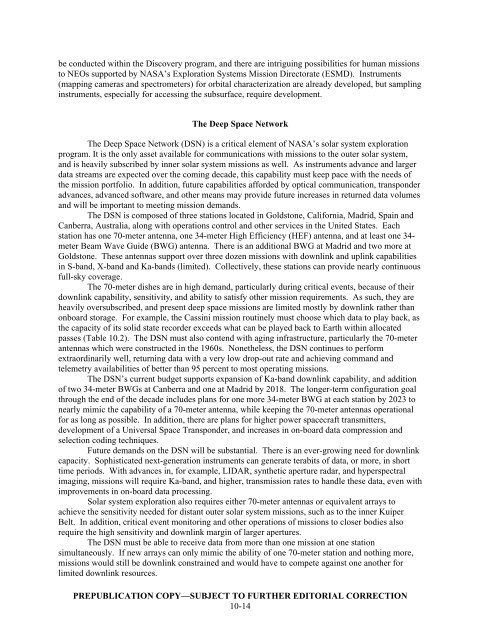Vision and Voyages for Planetary Science in the - Solar System ...
Vision and Voyages for Planetary Science in the - Solar System ...
Vision and Voyages for Planetary Science in the - Solar System ...
Create successful ePaper yourself
Turn your PDF publications into a flip-book with our unique Google optimized e-Paper software.
e conducted with<strong>in</strong> <strong>the</strong> Discovery program, <strong>and</strong> <strong>the</strong>re are <strong>in</strong>trigu<strong>in</strong>g possibilities <strong>for</strong> human missions<br />
to NEOs supported by NASA’s Exploration <strong>System</strong>s Mission Directorate (ESMD). Instruments<br />
(mapp<strong>in</strong>g cameras <strong>and</strong> spectrometers) <strong>for</strong> orbital characterization are already developed, but sampl<strong>in</strong>g<br />
<strong>in</strong>struments, especially <strong>for</strong> access<strong>in</strong>g <strong>the</strong> subsurface, require development.<br />
The Deep Space Network<br />
The Deep Space Network (DSN) is a critical element of NASA’s solar system exploration<br />
program. It is <strong>the</strong> only asset available <strong>for</strong> communications with missions to <strong>the</strong> outer solar system,<br />
<strong>and</strong> is heavily subscribed by <strong>in</strong>ner solar system missions as well. As <strong>in</strong>struments advance <strong>and</strong> larger<br />
data streams are expected over <strong>the</strong> com<strong>in</strong>g decade, this capability must keep pace with <strong>the</strong> needs of<br />
<strong>the</strong> mission portfolio. In addition, future capabilities af<strong>for</strong>ded by optical communication, transponder<br />
advances, advanced software, <strong>and</strong> o<strong>the</strong>r means may provide future <strong>in</strong>creases <strong>in</strong> returned data volumes<br />
<strong>and</strong> will be important to meet<strong>in</strong>g mission dem<strong>and</strong>s.<br />
The DSN is composed of three stations located <strong>in</strong> Goldstone, Cali<strong>for</strong>nia, Madrid, Spa<strong>in</strong> <strong>and</strong><br />
Canberra, Australia, along with operations control <strong>and</strong> o<strong>the</strong>r services <strong>in</strong> <strong>the</strong> United States. Each<br />
station has one 70-meter antenna, one 34-meter High Efficiency (HEF) antenna, <strong>and</strong> at least one 34meter<br />
Beam Wave Guide (BWG) antenna. There is an additional BWG at Madrid <strong>and</strong> two more at<br />
Goldstone. These antennas support over three dozen missions with downl<strong>in</strong>k <strong>and</strong> upl<strong>in</strong>k capabilities<br />
<strong>in</strong> S-b<strong>and</strong>, X-b<strong>and</strong> <strong>and</strong> Ka-b<strong>and</strong>s (limited). Collectively, <strong>the</strong>se stations can provide nearly cont<strong>in</strong>uous<br />
full-sky coverage.<br />
The 70-meter dishes are <strong>in</strong> high dem<strong>and</strong>, particularly dur<strong>in</strong>g critical events, because of <strong>the</strong>ir<br />
downl<strong>in</strong>k capability, sensitivity, <strong>and</strong> ability to satisfy o<strong>the</strong>r mission requirements. As such, <strong>the</strong>y are<br />
heavily oversubscribed, <strong>and</strong> present deep space missions are limited mostly by downl<strong>in</strong>k ra<strong>the</strong>r than<br />
onboard storage. For example, <strong>the</strong> Cass<strong>in</strong>i mission rout<strong>in</strong>ely must choose which data to play back, as<br />
<strong>the</strong> capacity of its solid state recorder exceeds what can be played back to Earth with<strong>in</strong> allocated<br />
passes (Table 10.2). The DSN must also contend with ag<strong>in</strong>g <strong>in</strong>frastructure, particularly <strong>the</strong> 70-meter<br />
antennas which were constructed <strong>in</strong> <strong>the</strong> 1960s. None<strong>the</strong>less, <strong>the</strong> DSN cont<strong>in</strong>ues to per<strong>for</strong>m<br />
extraord<strong>in</strong>arily well, return<strong>in</strong>g data with a very low drop-out rate <strong>and</strong> achiev<strong>in</strong>g comm<strong>and</strong> <strong>and</strong><br />
telemetry availabilities of better than 95 percent to most operat<strong>in</strong>g missions.<br />
The DSN’s current budget supports expansion of Ka-b<strong>and</strong> downl<strong>in</strong>k capability, <strong>and</strong> addition<br />
of two 34-meter BWGs at Canberra <strong>and</strong> one at Madrid by 2018. The longer-term configuration goal<br />
through <strong>the</strong> end of <strong>the</strong> decade <strong>in</strong>cludes plans <strong>for</strong> one more 34-meter BWG at each station by 2023 to<br />
nearly mimic <strong>the</strong> capability of a 70-meter antenna, while keep<strong>in</strong>g <strong>the</strong> 70-meter antennas operational<br />
<strong>for</strong> as long as possible. In addition, <strong>the</strong>re are plans <strong>for</strong> higher power spacecraft transmitters,<br />
development of a Universal Space Transponder, <strong>and</strong> <strong>in</strong>creases <strong>in</strong> on-board data compression <strong>and</strong><br />
selection cod<strong>in</strong>g techniques.<br />
Future dem<strong>and</strong>s on <strong>the</strong> DSN will be substantial. There is an ever-grow<strong>in</strong>g need <strong>for</strong> downl<strong>in</strong>k<br />
capacity. Sophisticated next-generation <strong>in</strong>struments can generate terabits of data, or more, <strong>in</strong> short<br />
time periods. With advances <strong>in</strong>, <strong>for</strong> example, LIDAR, syn<strong>the</strong>tic aperture radar, <strong>and</strong> hyperspectral<br />
imag<strong>in</strong>g, missions will require Ka-b<strong>and</strong>, <strong>and</strong> higher, transmission rates to h<strong>and</strong>le <strong>the</strong>se data, even with<br />
improvements <strong>in</strong> on-board data process<strong>in</strong>g.<br />
<strong>Solar</strong> system exploration also requires ei<strong>the</strong>r 70-meter antennas or equivalent arrays to<br />
achieve <strong>the</strong> sensitivity needed <strong>for</strong> distant outer solar system missions, such as to <strong>the</strong> <strong>in</strong>ner Kuiper<br />
Belt. In addition, critical event monitor<strong>in</strong>g <strong>and</strong> o<strong>the</strong>r operations of missions to closer bodies also<br />
require <strong>the</strong> high sensitivity <strong>and</strong> downl<strong>in</strong>k marg<strong>in</strong> of larger apertures.<br />
The DSN must be able to receive data from more than one mission at one station<br />
simultaneously. If new arrays can only mimic <strong>the</strong> ability of one 70-meter station <strong>and</strong> noth<strong>in</strong>g more,<br />
missions would still be downl<strong>in</strong>k constra<strong>in</strong>ed <strong>and</strong> would have to compete aga<strong>in</strong>st one ano<strong>the</strong>r <strong>for</strong><br />
limited downl<strong>in</strong>k resources.<br />
PREPUBLICATION COPY—SUBJECT TO FURTHER EDITORIAL CORRECTION<br />
10-14











